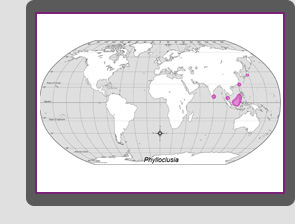| |

Characteristics
Phylloclusia Hendel species are slender and yellow with dark stripes and spots, and are among the largest Clusiidae (4.5-7.3 mm in length). The genus includes six species found in Japan, Taiwan and Southeast Asia, and was last treated by Lonsdale & Marshall (2007d), who revised the genus.
The defining synapomorphies of Phylloclusia include the following: one pair of lateral scutellar bristles; anterior dorsocentral no more than half length of posterior dorsocentral; posterior 1/3 of scutum shiny between dorsocentral bristles; frons shiny, slightly constricted posteriorly and with anterior margin produced as a shallowly ridge; lower ¾ of face brown (sometimes appearing as a central spot); notum elongate with postpronotum bulging. Phylloclusia species also have very long prescutellar acrostichal bristles and no dorsal preapical tibial bristles, and the Japanese and Southeast Asian species have a laterally compressed arista (a similar arista also occurs in the European Hendelia beckeri Czerny), a long triangular first flagellomere, yellow bristles and a carinate face.
Relationships
The most closely related genus, Tetrameringia McAlpine (also found in Japan), has a more southerly distribution, with most species described from Madagascar, South Africa, Malawi and eastern Australia (Barraclough, 2000, 2002; McAlpine, 1960; Sueyoshi, 2006; Stuckenberg, 1973). Phylloclusia is considered the sister-group to Tetrameringia on the basis of the following male and female genitalic synapomorphies: posterior margin of male sternite 6 setose; surstylus small, thin and subtriangular; distiphallus broken medially and reflexed; ventral shield of phallapodeme raised from shaft (except in P. quadrivittata Sueyoshi); spermatheca pigmented, irregularly-shaped and with minute transverse grooves (smooth and spherical in T. borealis Sueyoshi); spermathecal duct with subbasal attachment to spermatheca.
Biology
Little is known of the biology of Tetrameringia and Phylloclusia, but P. darlingi Lonsdale & Marshall has been collected in a log emergence trap, and specimens of Tetrameringia have been collected around creeks and small streams in shaded areas (McAlpine, 1960). Australian Tetrameringia have also been collected by sweeping over a moist stream bed in an otherwise dry forest. Immature stages are unknown.
North American species: None. |
|
 |